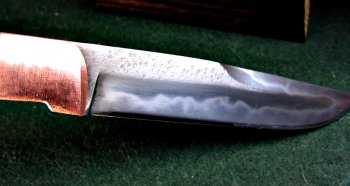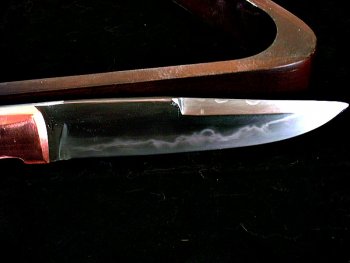Jesus Hernandez has a tutorial about making habaki on his website.
Pavel Bolf has a good video on youtube about making habaki (he makes one, doesn't talk, just makes one). I have a youtube channel colwellk2 where you can find the habaki making as a playlist.
You can reclay, reheat, requench. Just put a light wash of clay (about 1 grain of clay thick) over the whole thing. Then, but a line about a tenth of an inch thick about a third of the way down the blade from the spine. Make it wavy. Then, fill in to the spine with clay the same thickness. Now, put lines of clay in little upside-down v's with the notch of the "v" against the line of clay and the two legs of the v running down to the edge. Put about one of these per inch of blade. Make each of these about a 16th of an inch thick and a 16th to an 8th wide. Put a series of very shallow, very short, very thin lines from the edge up about a half an inch. Put one of these lines about every third of an inch. These will help add activity and help keep the edge from cracking.
heat to non-magnetic, slowly, taking the whole thing out of the forge a couple of times after it turns dull red (in the dark). Go about 75F past nonmag. Quench the blade in hot water from your tap for 3 sec. Take it out and immediately put it into some form of oil (parks, canola, mineral, olive...). I reccommmend those, in that order. Remove from forge, line up so the quench will be straight, quench for 3 in water, quench for 15 or so in oil. Remove and look for bends, you have about 30-50 seconds where you can bend the steel with your hand and a glove. Especially try to get rid of any twists. Since this will have a soft back, you can hammer any bends out later (cold). Twists are the biggest problem, and you can remove them with good gloves if you act before the martensite fully sets. EDITED TO ADD: when you feel the steel setting, put it back in the oil or the hot water. If you are going to let it sit any time at all put it in the hot water. Take it asap and test edge for hardness with file and go straight to tempering oven. If you are brave, you can do the Japanese trick of just running it back through the forge a couple of times to stress relieve/temper. I like more control and use my kitchen oven on about 400-425F depending on length. Longer = hotter. If w2, temper about 10F to 15F hotter.
Polishing is even a bigger process. But, this will set you with a good hamon. I suggest the lowest manganese 1095, but even better is w2, and even even better is Aldo's low manganese 1075. W1 and old nicholson files are also quite good. Another of the really good steels is Extra-Improved Plow Steel wire rope. This stuff looks like tamahagane but performs like modern steel. You have to weld it and fold/draw out 4 or 5 times, but it is beautiful with both grain and hamon.
If you want some wire rope I can send it to you. If you need it welded first, I can forge you a billet and draw it out, cut, weld... a couple of times. I will trade for billets or just send you some cable to use yourself in raw form. You have to get the right stuff EIPS and not any of the other kinds.
Hope you don't mind the long answer.
I have been enjoying the process. Thanks for sharing.
Kevin








